
Hubbard Glacier Vs. Glacier Bay National Park? It’s a question asked a lot, especially by first-time visitors planning an Alaska cruise.
No doubt, Glacier Bay National Park and Hubbard Glacier provide the best cruise itineraries in Alaska. And you’d be thrilled with either choice.
If you poll the audience, the answer can be different due to the weather and how close they got to a glacier. Bear in mind; that these are not the only two places cruise ships sail.
Other itineraries include Tracy Arm, Endicott Arm, and College Fjord, so I will cover all of these itineraries.
Since College Fjord is much further north than the others, it is only available on one-way cruises from Vancouver to Whittier or Seward, or vice versa, and not on roundtrip itineraries out of Seattle and Vancouver.
Back-to-back 14-day itineraries can include Glacier Bay National Park, Hubbard Glacier, and College Fjord. I’ve done this once with Princess Cruises, which gave me an overload of glacial experience that I won’t soon forget.

Most Alaskan cruises include one or more viewings of a sizeable glacial icefield. When trying to choose a cruise line for sailing Alaska, don’t choose by cruise line alone.
Instead, decide on the itinerary and cruise to Alaska with the best line that goes there. Remember to factor in port times. Some dock for a full day, while others stay for half a day.
Hubbard Glacier, The Mighty One
- Location: Disenchantment Bay
Nicknamed the “galloping glacier,” Hubbard is one of the few Alaskan glaciers that is rapidly advancing.
The largest tidewater glacier in North America, Hubbard Glacier measures 76 miles long from the top of the icefield and plunges 1,200 feet into the bay. Its immense beauty and phenomenal blue hues are enchanting, even from a distance.
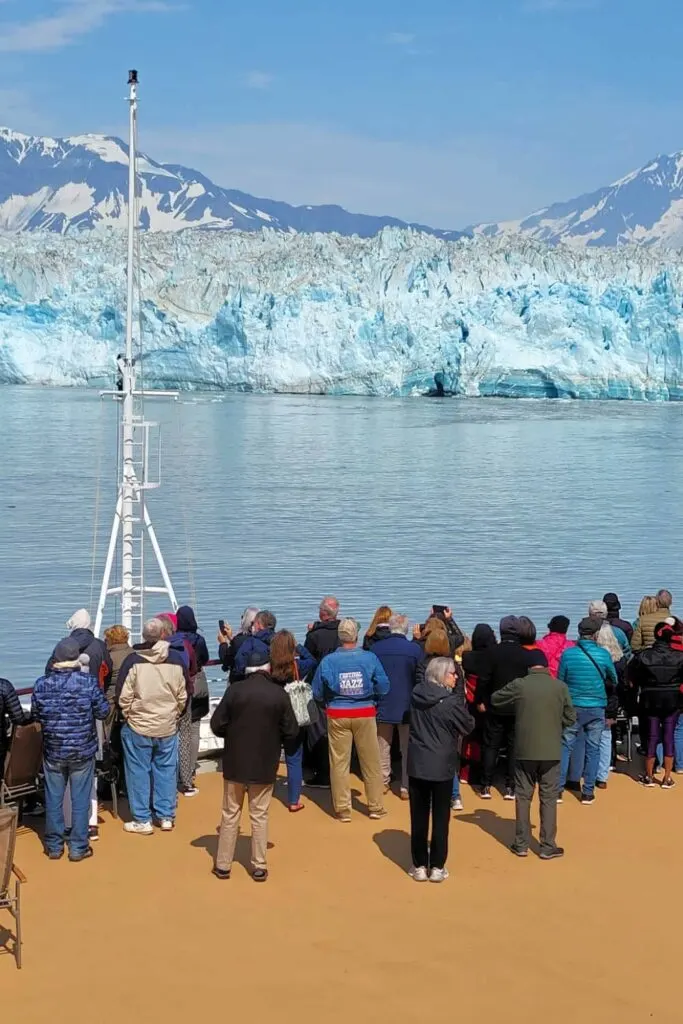
Hubbard is big, very BIG. In fact, pictures don’t do this glacier justice because the whole glacier won’t fit in the photo.
It’s 7 miles long and 400 feet high. Imagine looking up at a 50-story building; that’s how high Hubbard is. Its blue hues are mesmerizing, and Hubbard viewings provide memorable experiences.
My very first cruise was to Hubbard Glacier in Alaska. Being my inaugural cruise experience, it was a special one. During my cruise, I saw just this one glacier, but it’s one impressive icefield.
Scenic cruising through Yakutat Bay into Disenchantment Bay provides landscape changes from browns and greens to white. If you cruise in early May, the snow-capped mountains blend seamlessly with the glacial ice of Hubbard.
It’s a spectacular vision of white, and sometimes hard to distinguish where the glacier ends and the mountains begin. In June, the landscape around Hubbard Glacier begins to melt and make way for different tones.
Sometimes the bay has an abundance of ice, which prevents cruise ships from getting too close. On my first trip (in the third week of July), the cruise ship got within ¼ mile of its face.

Being that we could get so close and the weather was in my favor made sailing to Hubbard was a magical experience. On my Cunard Queen Elizabeth cruise, we got even closer and saw stellar sea lions and lots of harbor seals.
At the terminus, its towering facade impresses, dwarfing the uppermost decks of every cruise ship. Due to its size, guests can view from every spot on the cruise ship.
To enjoy the best views, head to the open deck. If you prefer to watch from your balcony cabin, the captain will swing the vessel around so both sides have equal viewing time.
A trip to Hubbard will include a few hours at the Glacier, plenty of time to witness and hear the thundering sounds of calving.
If you have never experienced carving, it’s a wonderful treat. First, you hear the thunder, then the cracking as a massive piece of ice slides down into the bay.
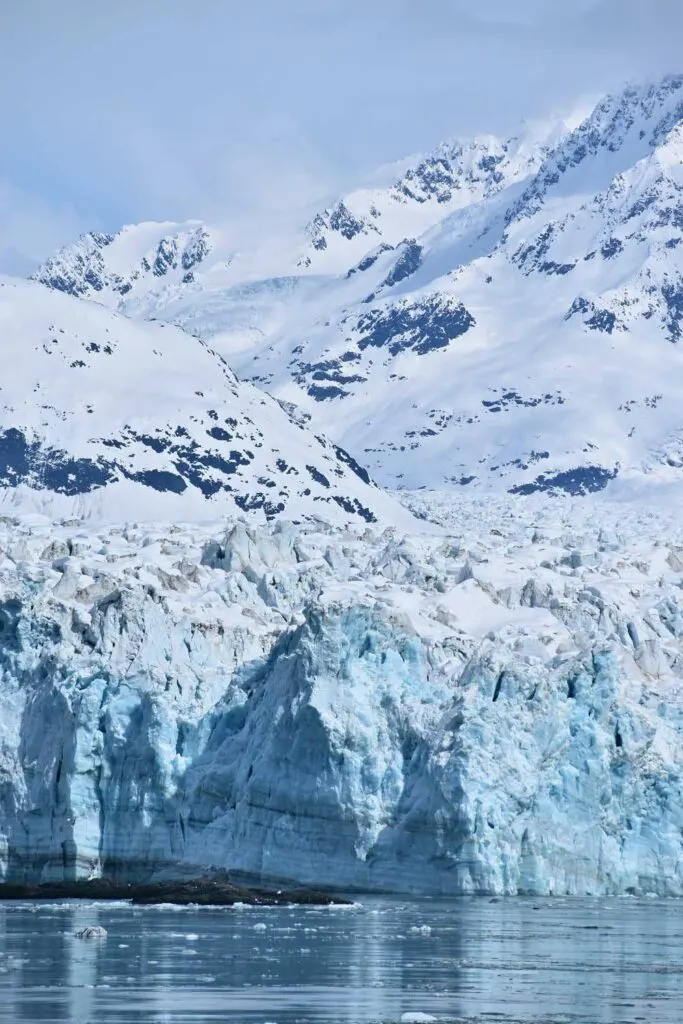
Due to the advancement of Hubbard, it’s the preferred itinerary to witness calving. Should you choose an itinerary early in the season before all ships have repositioned, you can find cruises that sail to Hubbard Glacier and a fjord.
The Pros And Cons Of Visiting Hubbard Glacier
Pros
- It’s the biggest glacier, which begins in British Columbia, Canada.
- Hubbard is advancing, so it provides plenty of calving.
- Disenchantment Bay has nine of the highest North American peaks.
- It has beautiful blue hues.
Cons
- There’s only one glacier in the bay.
- Ice sometimes blocks the channel, which prevents ships from getting close.
- It can be extremely foggy, obscuring the views.
- It’s typically a shorter visit of a couple of hours.
Glacier Bay National Park
- Location: 93 miles (1.61 km) west of Juneau
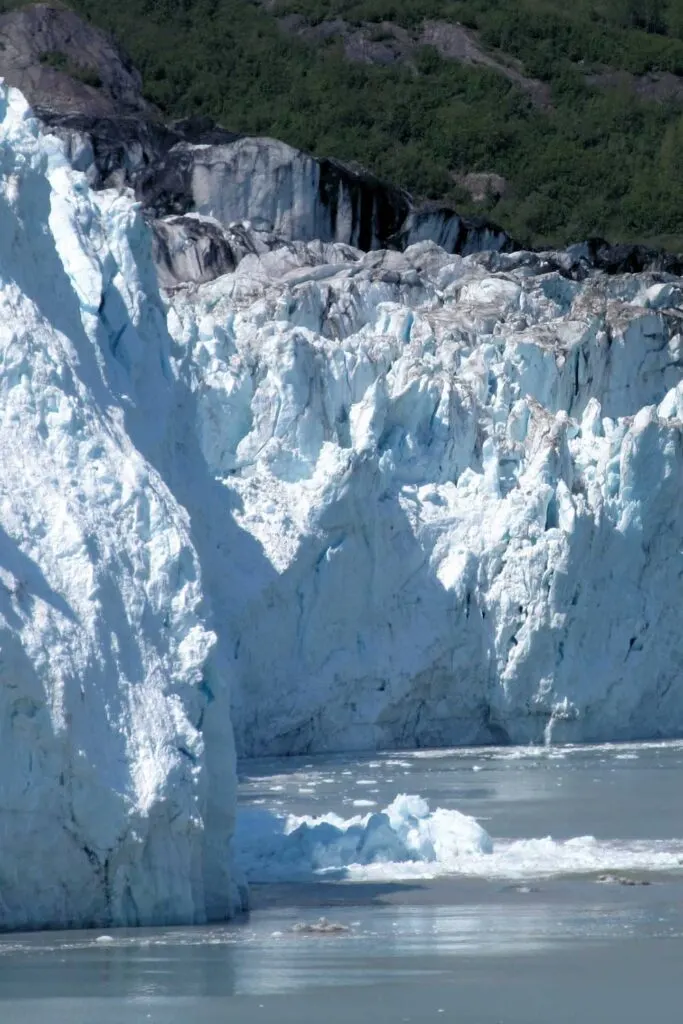
Often, cruisers consider Glacier Bay National Park as the premium Alaska itinerary. Glacier Bay allows just two cruise ships a day to sail its waters, and park rangers must accompany vessels.
Cruise lines gain access by way of a lottery drawing, except for Princess Cruises and Holland America, which have long relationships with Alaska.
An itinerary of Glacier Bay includes a full day in the park, which has seven tidewater glaciers. Due to global warming, most glaciers are receding. However, Margerie Glacier, as well as Johns Hopkins Glaciers, are advancing.
For the majority of ships, Margerie Glacier is the first viewable glacier in the park. Also, it is the most photogenic glacier, and it’s easy to see why.
The glacial ice is mesmerizing with its varied tones of aqua and blue. And after a short stay here, it’s hard to top its majestic presence and its stunning appeal.
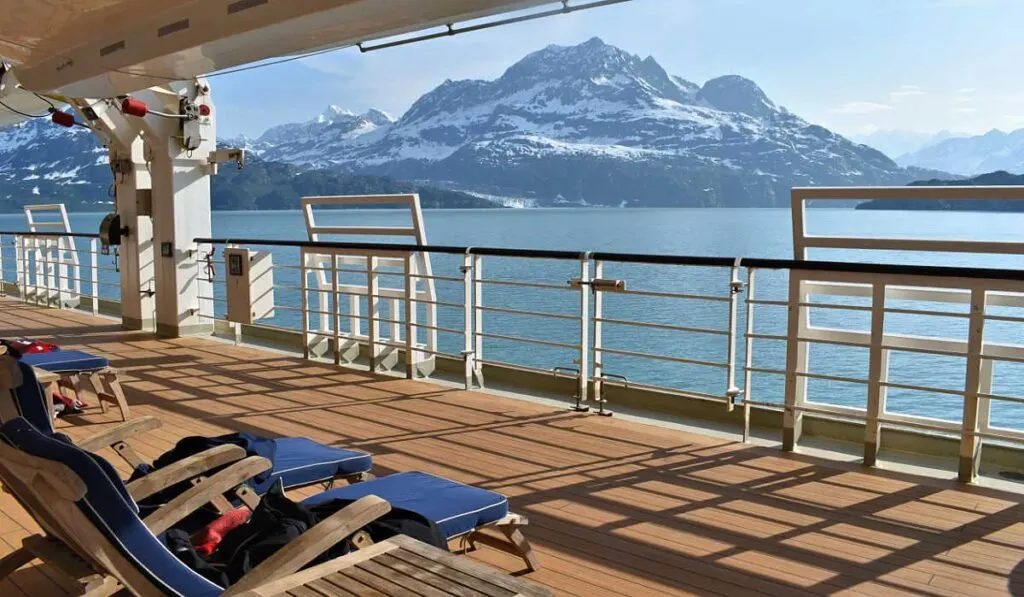
Margerie is one of the most active ice masses for calving. During a visit, listen to the earth-shattering thunder of the ice cracking and the spectacular “calving” in full action.
It’s interesting to note that Margerie Glacier is a much cleaner glacier with less debris compared to the Grand Pacific Glacier located adjacent to it.
Being one of the most active glaciers in the bay, Johns Hopkins Glacier is advancing at a flow rate of 10 to 15 feet a day. The Inlet is a vital harbor seal breeding ground. The icebergs below the glacier are a great place to spot them.
Because of this, the inlet head is off-limits to cruise ships and larger passenger vessels. Instead, you can enjoy the panoramic views with beautiful blue hues and an abundance of icebergs from a distance.
Located near the entrance to Johns Hopkins, the Lamplugh Glacier flows from Brady Icefield. Lamplugh has been receding rapidly, mostly from the center of the terminus.
In the summer of 2016, a huge landslide dumped millions of tons of debris onto the glacier. From the air, 9 km of dirty rock is seen coating the surface.

Not only can you hear and see the glacial ice exploding, but there’s a chance to see harbor seals and humpback whales too. Remember to pack compact binoculars as you can spot black bears on the shorelines.
Glacier Bay National Park is a unique and powerful place that needs to be experienced. Many favor Glacier Bay because it offers multiple Alaska glaciers in one place.
For the 2024 Alaskan cruise season, the Viking Orion, Seabourn Odyssey, and American Constellation visit the UNESCO World Heritage Site along with the following:
| Cunard | Queen Elizabeth |
| Holland America | Zaandam, Noordam, Eurodam, Koningsdam, Nieuw Amsterdam, Westerdam |
| Norwegian | Sun, Encore, and Spirit |
| Princess | Grand, Ruby, Royal, Discovery, Crown, Sapphire |
The Pros And Cons Of Visiting Glacier Bay
Pros
- It has seven tidewater glaciers.
- Passengers often see black bears on the shorelines.
- Glacier Bay is a UNESCO World Heritage Site.
- A Park Ranger accompanies the cruise giving commentary on the scenery and wildlife.
- You’ll spend the most time in Glacier Bay, up to nine hours.
- You’ll generally experience warmer temperatures than at Hubbard Glacier.
Cons
- Only a select number of cruises go to Glacier Bay.
- There is less calving action than at Hubbard Glacier.
- This itinerary can command higher prices.
Tracy Arm And Twin Sawyer Glaciers
- Location: 43 miles (1.61 km) southeast of Juneau
Tracy Arm is the name of a fjord that leads up to the twin Sawyer Glaciers. It is located 45 miles south of Juneau, in southeast Alaska.
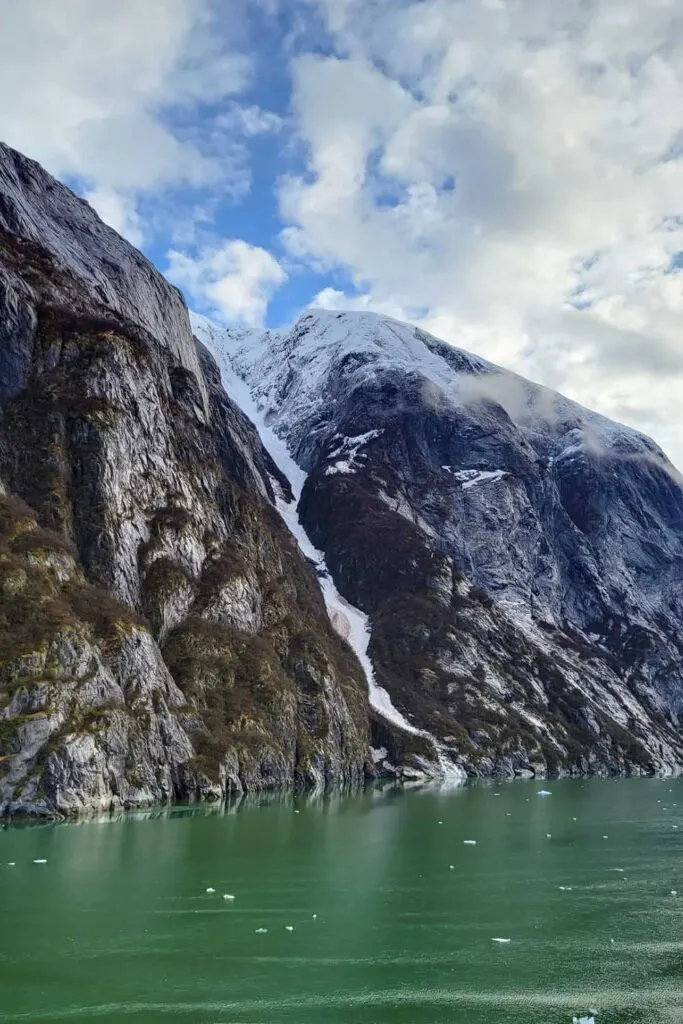
If you choose this particular itinerary, check to see if the itinerary has any cruising time in the bay. Some cruise lines don’t sail in the fjord. Instead, they schedule a 30-minute stop at Tracy Arm.
To see South Sawyer Glacier, you must book an excursion through your cruise line. You will board a smaller vessel from your cruise ship outside the fjord and end your tour in Juneau, where the cruise ship is docked.
If Tracy Arm contains too much ice or if there’s too much fog, the cruising portion f this cruise will be canceled.
Tracy Arm Fjord is 30 miles long and very narrow and aptly named the most majestic fjord in Alaska. In some areas, only half a mile wide.
As a result, mega-ships can’t navigate the narrow fjord. The fjords’ walls are very steep and craggy, which provide many plunging waterfalls.

This region is a haven for Alaskan wildlife. Cruisers can often spot grazing mountain goats on the granite cliffs, and bears scour the shorelines for food. Orca and humpback whales swim the waters of Stephen’s Passage, knowing there are seals nearby.
Hundreds of icebergs dot the jade-colored waters, creating a picture-perfect scenery right out of a National Geographic magazine. Harbor seals and their pups soak up the sun on the bergs, almost posing for photos as we cruised by.
The evergreen Fjord is home to a spectacular array of seabirds, including pigeon guillemots, kittiwakes, arctic terns, and bald eagles. Remember to bring a pair of binoculars for optimal viewing.
At half a mile wide, twin Sawyer Glaciers are not as big as Hubbard but still provide excellent calving action. The South Sawyer Glacier is larger than its sister in the northern arm and more accessible.
The Pros And Cons Of Visiting Tracy Arm
Pros
- It’s an authentic fjord experience with cliffs.
- The fjord has lots of scenic waterfalls.
- You can see eagles, whales, mountain goats, and many bird species.
- Lots of icebergs with hundreds of harbor seals.
- Some cruise lines sell a Tracy Arm Fjord & Glacier Explorer excursion which gets you closer to the waterfalls and glacier.
Cons
- Ice sometimes blocks the fjord, rerouting ships to Endicott Arm instead or skipping the fjord altogether.
- Mega cruise ships can’t access the smaller fjords.
- An early morning visit often cuts the port time in Juneau later in the afternoon.
College Fjord
- Location: 507 miles (815.9 km) northwest of Juneau
A College Fjord itinerary is only available on a one-way Alaska cruise from Vancouver, Canada, or from Whittier or Seward southbound to Vancouver. The fjord contains five tidal glaciers, five valley glaciers, and many smaller glaciers.
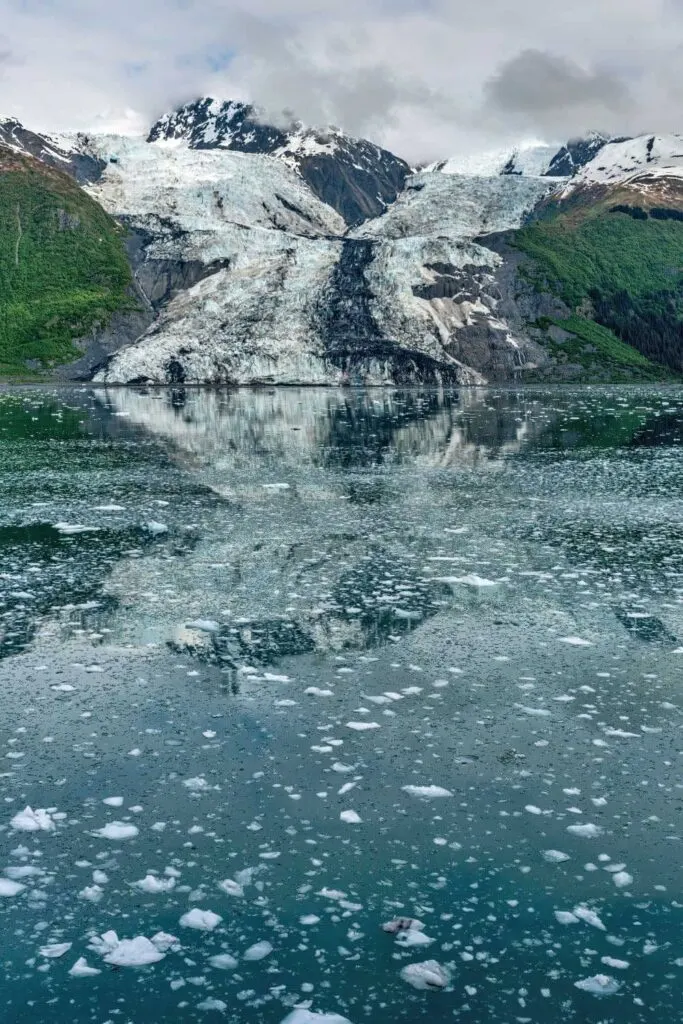
Most of the glaciers are named after renowned east coast colleges, with the women on the NW side and the men on the SE section.
Harvard Glacier is the largest of the College Fjord glaciers, and it is the second-largest tidewater glacier in Prince William Sound.
Tidewater glaciers are valley glaciers that flow all the way down to the ocean. Additionally, the most active tidewater glaciers in the world are in Prince William Sound.
While there aren’t too many cruise ships that visit College Fjord, this is an itinerary not to be missed. Unlike glaciers in other areas, these are positioned close together, like soldiers all in a row.
However, since College Fjord is much further north, you may experience colder, foggy, or rainy conditions, which can affect visibility.
The Pros And Cons Of Visiting College Fjord
Pros
- There are multiple glacier viewings.
- The glaciers are close together.
- Your itinerary often includes Glacier Bay National Park too.
Cons
- Due to being further north, the fjord is often foggy and the weather unfavorable.
- Not as much wildlife.
- Only available on a one-way cruise.
Endicott Arm And Dawes Glacier
- Location: 63 miles (101.3 km) southeast of Juneau
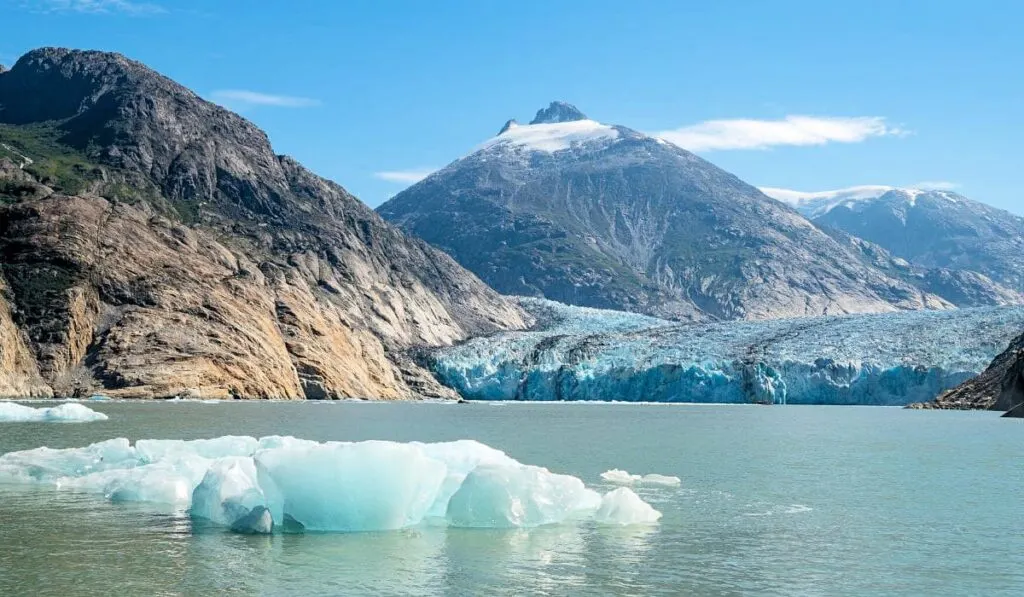
Like Tracy Arm, a voyage through Endicott experiences a real fjord experience with cliffs and gushing waterfalls. Both Sawyer Glaciers and Dawes Glacier are in fjords off Holkham Bay.
To the south, Endicott Arm is less affected by weather conditions and is the backup itinerary to Tracy Arm should it be blocked by ice. These wilderness valleys are home to numerous sea birds, harbor seals, bears, bald eagles, and the occasional whale pods.
Additionally, sailing a small fjord allows the traveler to get up close and personal with the natural habitat. The steep granite cliffs and abundance of rain provide dramatic waterfalls and lush green space.
Like its neighboring cousin, Endicott Arm has lots of icebergs. These range from larger sizes to smaller pieces, called “bergy bits.” These bergy bits are floating islands of paradise for migratory birds.
Low down to the water, you can hear the pops as the ice bubbles escaped from the melting ice.
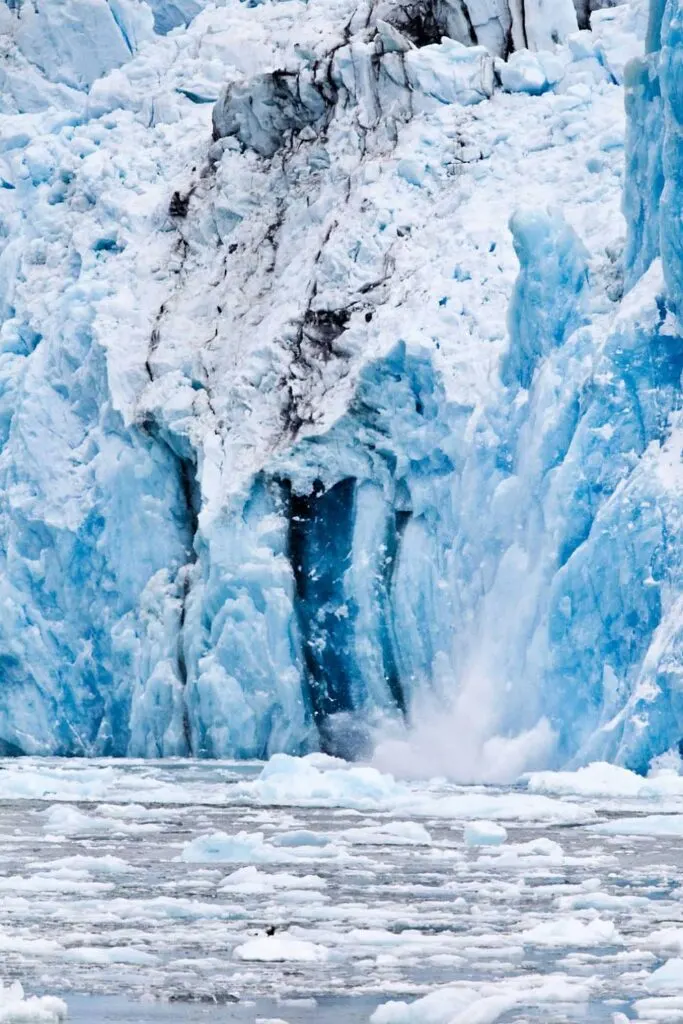
Smaller fjords are a breeding ground for harbor seals. So, should you cruise in May, travelers often see seals giving birth to pups on the nearby icebergs. At the end of the fjord, Dawes Glacier delights cruisers with its beautiful blue hues.
Standing half a mile wide and six hundred feet tall, cruisers have a chance to witness its phenomenon calving action.
The Pros And Cons Of Visiting Endicott Arm
Pros
- It provides a true fjord experience with granite cliffs and waterfalls.
- Harbor seal and sea bird viewings.
Cons
- There’s only one glacier.
- Not as much calving action as Hubbard Glacier.
- If you travel early in the Alaska season, ice may prevent your cruise ship from getting to the glacier.
Hubbard Glacier Vs. Glacier Bay Comparison
When cruising to Alaska, it’s not a matter of Hubbard Glacier Vs. Glacier Bay. After all, every cruise experiences jaw-dropping scenery no matter what the itinerary.
Having sailed all possible itineraries to Alaska, I would choose either Glacier Bay National Park or Hubbard Glacier because one provides multiple glaciers and the other the best calving.
If you plan only one trip to Alaska and want to see it all or as much as possible, consider a back-to-back itinerary from Vancouver’s port. On a B2B cruise, you’ll visit Glacier Bay twice, and travel to both Hubbard Glacier and College Fjord.
Also, when visiting Alaska’s capital, you’ll have a chance to enjoy Mendenhall Glacier, part of the Juneau icefield. Getting to Mendenhall Glacier is relatively easy as shuttle buses continually run back and forth, taking cruise passengers to the park.


Nancy
Friday 2nd of June 2023
Hello Karen, I'm so glad to have stumbled on your page. You've done all I've ever dreamed of doing and beyond. My goal has been wanting to travel all over the world. My main issue is finding travel companions. I don't need a 24/7 companion just a pleasant, trustworthy person to share some conversations with. Do you have any suggestions? I appreciated and thank you for your article.
Forever Karen
Saturday 3rd of June 2023
Nancy, I've met many people in your position. Some ships have solo cabins, so you don't need to pay the single supplement. You could try looking on Cruise Critic to find a travel companion?